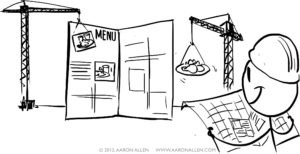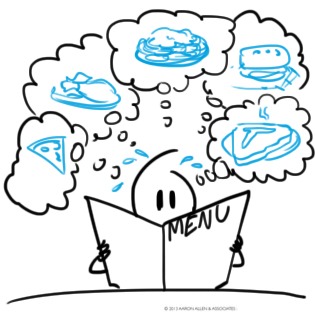The menu is the single most important piece of marketing collateral for any restaurant. A well-designed menu can consistently increase profits for any restaurant (whether an independent or national chain) by as much as $1,000 per month, per million dollars in annual revenue.
Re-engineering and designing menus is vital to this process. Think of the menu as a piece of real estate with, and restaurateurs are the landlords. Are all of the renters (menu items) paying their fair share? Here are some of the most common restaurant menu design mistakes we see.

1. MENU ITEM PLACEMENT
Haphazard placement of profitable items decreases their value. Menu engineering is an important step in reaching profit potential, so consider each item from the perspective of its profit margin and popularity. The most popular and profitable items should rise to the top of a menu and should be obviously apparent to guests.
Often, these high-earning items fall into a similar category, like seafood or steak, making them easy to organize. Not highlighting the most profitable items means customers will be more likely to choose other dishes and missing out on potential profits.
2. TOO MANY DOLLAR SIGNS
The overuse of dollar signs makes appears too money-conscious, and makes it look like a restaurant is all about money over quality. Restaurateurs should do everything they can to communicate a tone of hospitality and welcoming, rather than business and profit.
For this reason, some restaurants incorporate prices into menu descriptions and list costs as numbers without dollar signs. Lining prices on one side or with dots leading to them directs the customers’ eyes over to the prices and encourages guests to scan for the least expensive items, rather than focusing on menu offerings themselves.
3. ITEM LEFT – PRICE RIGHT
Rather than “Chinese menu” style of pricing, with the item on left with and “….$price” on the right, use columns and nested pricing instead. The placement and format of prices has a huge psychological impact on guests. If prices are separated and justified on the right side of the page, visitors view the menu as generic and read from right to left, starting with the most inexpensive items instead of the most interesting.
The best menus facilitate easy scanning of creative item names and expertly written descriptions, and guests should make decisions based on what sounds and looks the best, not the price. Try nesting the price into the description of an item, using the same size font, or placing two spaces between the end of the description and the price. This way, the cost is listed but not emphasized.
4. NO VISIBLE MERCHANDIZING
A menu should function as a tour guide of the best signature items and those with the highest gross margin – it can be so much more than just a list of simple dishes offered. It should highlight those dishes that have the highest gross margin, taking guests on a tour of the items and elements that make a restaurant stand out from its competitors.
To help accomplish this, make sure to merchandise a minimum of one – but no more than two – item(s) on each page or panel of the menu. Don’t overdo the merchandising, but guests will often appreciate guidance and order highlighted items on a well-merchandized menu.
5. LACK OF DIGITAL MENU BOARDS
QSR or fast casual operators that still use static boards rather than migrating to digital menu boards lose out, as digital menu boards can lead to a return on investment (ROI) 28 percent higher on average. These boards give fast casual restaurant operators a great opportunity to display food photography and highlight different dishes each day.
In 2010, Burger King implemented digital menu boards in their London and Birmingham locations. Within one year, they saw a 64 percent increase in sales at those locations. Static menu boards are not only less interactive, but they are difficult to update when implementing menu changes. The profits of switching to digital menu boards will more than outweigh the costs.

6. TOO MANY OR TOO FEW ITEMS
People often want decisions made for them, or at least made easier. If there are too many dishes on a menu, guests will have a hard time choosing and will be less likely to return. Cut less successful items out of the menu and prune selections so that only the most popular and profitable listings remain. On the flip side, having too few items will also decrease guest frequency. If there is only one item on a menu that a guest likes, they will pick a restaurant with more options.
Find the perfect line between serving everything you can make and challenging chefs to create more dishes. Develop a menu that is mostly made up of unique, signature items, leaving room for about one third of the total dishes to be experimental, creative and fresh.
7. MISSING MOBILE COMPATIBILITY
Many restaurants haven’t put their menus on their website, or have menus that can’t be accessed from a mobile phone. Eighty percent of consumers say they think it is important to see a menu before settling on a restaurant, and 70 percent prefer to do this on a smartphone. Sixty-two percent of potential guests even go so far as to avoid restaurants that don’t have menus available online.
As the Internet becomes a stronger tool for restaurants, those that do not adapt will be left behind. Menus should be easily available online and should be formatted for mobile devices. This is a relatively inexpensive, simple task, but it is one that many restaurants have yet to accomplish.
8. UNKEMPT MENUS
Many physical menus are overly susceptible to food, grease and water stains, tears, and other common restaurant wear and tear. As with all things at a restaurant, the menu is a reflection of a brand and its values. If menus are worn and stained, the restaurant will appear to customers as old, dirty and cheap.
Restaurants should order menus that are durable, whether they are made from paper with a special matte finish or are laminated. Some establishments even go so far as to print their menus on wood or other unconventional, though brand-appropriate, materials, giving one of the most important pieces of restaurant collateral a unique aesthetic and increased durability.
9. INFREQUENT PRICING UPDATES
Many restaurants fail to conduct a competitive and profitability analysis at least twice per year, even though the price of food fluctuates greatly each year. Such fluctuations are normal and ongoing, and if restaurants don’t increase their menu prices when cost of food rise, they often lose their profit margins. On the other hand, having widely fluctuating prices isn’t a good idea either, so consider swapping out menu items if the price of ingredients is rising too quickly.
10. INFREQUENT ITEM UPDATES
In addition to evaluating menu pricing, evaluating and updating menu offerings should be done twice a year. If unpopular menu items are still on the menu, a restaurant won’t reach its full potential. Each item offered should be popular, and dishes that are rarely ordered should be replaced.
When looking for new menu items, look at the items already on the menu to see if there are ways new dishes can be created from those same ingredients. If brisket is the most popular item, for instance, offer a brisket salad or a brisket sandwich. Guests who already order the brisket are likely to try and like the new dishes.

11. NOT STAYING UP WITH THE TRENDS
Restaurants that build a menu based on what worked and was popular yesterday instead of what will be popular tomorrow are not relevant. Food prices, trends and tastes change regularly, and there are many indications of the trends that are gaining speed and going to take hold in the coming months. For instance, organic, ethical food has been gaining popularity in recent years, as have gluten-free options.
Make sure to update the menu and base it off of future trends instead of the ones that are already past their prime of popularity. For instance, a menu full of processed, hormone-raised foods will not do nearly as well as one that has healthy options and environmentally conscious ingredients, and even this trend is becoming dated. Guests are looking to restaurants to create what’s next, so keep current with industry publications and stay up with and ahead of the trends.
12. SELLING “LIKE ITEMS”
For a menu to reach its full potential, it has to be unique and efficient. Items that are comparable to competitors decreases its appeal, so avoid offering the same items as competitors or selling two items that are essentially the same. Don’t offer the same items as everyone else, and don’t sell two items that are essentially the same.
If both a BBQ brisket sandwich and plain brisket sandwich are on the menu, it’s portably safe to eliminate the plain option altogether, especially if it’s ordered less frequently. On the same token, if all of a restaurant’s competitors offer the same plate of spaghetti, customers will compare prices and choose the cheapest option. Create something new with no direct competition, and profit margins rise almost instantly.
13. NOT UTILIZING LIMITED TIME OFFERS
Limited time offers, or LTOs, create an opportunity for restaurants to show that they are constantly updating and staying fresh. They also create an opportunity to offer something new for guests to try, attract new diners and keep loyal customers happy. Employees can also get more excited by LTOs, as they have something new to feature when communicating with customers. Regularly updating and developing the menu is a great way to carry a restaurant brand forward. This allows a company to grow and change instead of settling into a stagnant rut.
14. MISSING SPECIALITY DRINKS
Specialty drinks are a great opportunity for restaurants to boost check average. Super-fruit drinks, smoothies and specialty flavored iced teas are opportunities for beverages for operations that don’t serve alcohol. Specialty drink menus make a restaurant relevant and attract customers back to your business more frequently. Make sure to include photos, as these are one of the most powerful tools in promoting menu items.
15. OFFERING MULTIPLE MENUS
Printing and offering too many separate menus can be confusing and overwhelming to customers. Just because a separate list for dinner, dinner specials, dessert, drinks and drink specials can be designed doesn’t mean they should. Design one menu with everything organized and consolidated in a logical manner that emphasizes the selections with the highest profit margin. An alternate drink menu can be appropriate if there is a large selection of alcoholic beverages, and a specials insert can be okay, too, if it suits the tone of the restaurant. But remember to keep things simple and uncomplicated, and make it easy for guests to see standout items.
16. UNDER-TRAINING STAFF
Allowing staff to sell the menu before they have been adequately trained and tested leads to costly mistakes. A restaurant’s waitstaff can’t properly sell the menu and act the part of knowledgeable, welcoming servers without proper training. Have new servers and hosts sit down with a chef or a manager and taste the most popular dishes, sauces and any unique drinks when they are hired.
The team should study the menu regularly and take verbal tests to see if they are ready to sell popular, profitable items. Before starting to sell, they should know the menu inside and out, and be able to answer questions about how dishes are prepared, which are most popular, and common allergens or dietary restrictions about each item.
17. MISSING MENU ITEMIZATION REPORTS
Not properly analyzing menu sales or underutilizing powerful back office tools and software to get a better understanding of the sales mix is a common mistake by many operators, both big and small. Reviewing and analyzing itemization reports regularly will lead to insights that might not be obvious at face value.
Take advantage of modern-day back office and analytical tools to review menu performance with metrics like sales per menu item, sales per category, monitor upsets and add-on popularity, and more to identify what areas of the menu are performing well, and – more importantly – figure out why certain items are selling more than others. This information will be valuable when the time comes for the next menu design and rollout.

18. UNDERWHELMING MENU COPY WRITING
Menu descriptions that are written by the chef, rather than by a professional copywriter with the assistance of the chef, are often confusing to guests. The primary goal of a menu is to maximize profits, and guests will get a lot more out of menu descriptions if they are written in a manner that sounds appetizing rather than simply technically correct. A chef is much more likely to write using industry jargon that other culinary professionals would understand, but visitors would not fully appreciate.
While the chef’s input is vital for having a menu that is correct, they should consult with copywriters instead of writing the menu themselves. Make sure item descriptions make customers hungry and read more like an explanation than a recipe.
19. ILLOGICAL MENU LAYOUTS
Inefficient layout or overuse of add-on prices for menu item variations is frustrating and confusing. The menu layout should be logical, with the most profitable items emphasized and organized in a manner that makes the entire menu easy to scan and read. Item variations should either be the same price, or the price should be listed in a logical place. For instance, the price for substituting onion rings for fries should be listed at the top of the burger section. Sides should either be listed next to each section, or in one clearly outlined area near the bottom of the menu.
It’s best to minimize the prices for menu item variations, as customers often miss these and are surprised when the bill is higher than they expected. To balance, consider averaging the price of items that are similar. For instance, if a cup of soup costs a little bit more than a house salad and visitors commonly order both, average the two and charge the same price for each option.
20. LAGGING PRICE ADJUSTMENTS
Waiting too long to adjust prices (or adjusting them too quickly) to account for food cost fluctuations can lower profit margins. Monitor price fluctuations and slowly adjust the menu to account for inflation of a meal’s ingredients. Make sure adjustments are gradual and avoid adding a dollar or more to the price all at once. This is a great way to keep your margins and account for rising food costs without upsetting your customers.
Waiting too long to increase prices may lose customers when charges raise significantly all at once. On the flip side, failing to increase prices at all can cause margins to drop and noticeably lower profits. Avoid both situations by regularly analyzing the profitability of the menu.
![]()
Check out the 20 Most Common Restaurant Service Mistakes and 20 Most Common Restaurant Design Mistakes, too.
